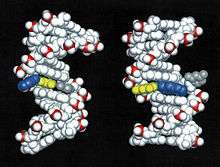DNA adduct

In molecular genetics, a DNA adduct is a piece of DNA covalently bonded to a (cancer-causing) chemical. This process could be the start of a cancerous cell, or carcinogenesis. DNA adducts in scientific experiments are used as biomarkers of exposure[1] and as such are themselves measured to reflect quantitatively, for comparison, the amount of carcinogen exposure to the subject organism, for example rats or other living animals. Under experimental conditions for study, such DNA adducts are induced by known carcinogens, of which commonly used is DMBA (7,12-dimethylbenz(a)anthracene). For example, the term "DMBA-DNA adduct" in a scientific journal refers to a piece of DNA that has DMBA attached to it. The presence of such an adduct indicates prior exposure to a potential carcinogen, but does not by itself indicate the presence of cancer in the subject animal.[2]
Examples

Chemicals that form DNA adducts include:
- acetaldehyde, a significant constituent of tobacco smoke
- cisplatin, which binds to DNA and causes crosslinking, leading to death of the cell
- DMBA (7,12-dimethylbenz(a)anthracene)
- malondialdehyde, a naturally occurring product of lipid peroxidation[3]
DNA adducts include:
- etheno-DNA adducts: 1,N(6)-etheno-2'-deoxyadenosine (epsilondA) and 3,N(4)-etheno-2'-deoxycytidine (epsilondC)
By-products include:
- M1G, a by-product of base excision repair (BER) of a specific type of DNA adduct called M1dG.
DNA Damage
When a chemical binds to DNA, the DNA becomes damaged, and proper and complete replication cannot occur to make the normal intended cell. This could be the start of a mutation, or mutagenesis. Without effective DNA repair, which happens naturally under normal circumstances, this can lead to carcinogenesis, the beginnings of cancer.
See also
References
- ↑ La, DK; Swenberg, JA (1996). "DNA adducts: biological markers of exposure and potential applications to risk assessment.". Mutation Research/Reviews in Genetic Toxicology 365 (1-3): 129–146. doi:10.1016/s0165-1110(96)90017-2.
- ↑ Farmer, P. "Biomarkers of exposure and effect for environmental carcinogens, and their applicability to human molecular epidemiological studies". Public Health Applications of Human Biomonitoring. U.S. EPA. Retrieved 22 June 2011.
- ↑ Lipid peroxidation-DNA damage by malondialdehyde. Marnett LJ.